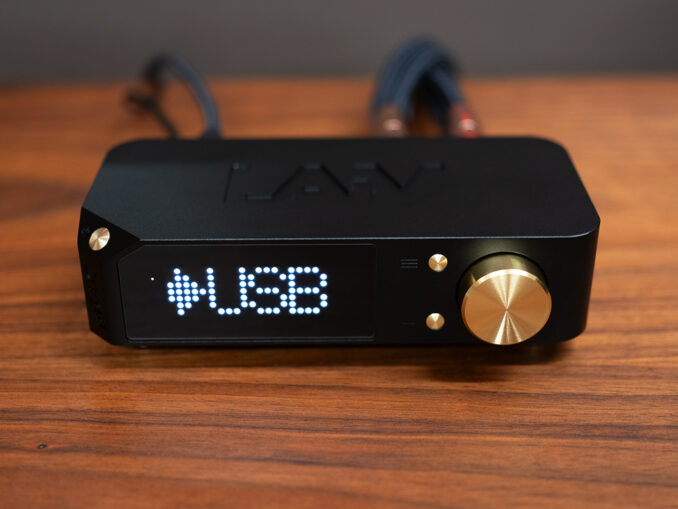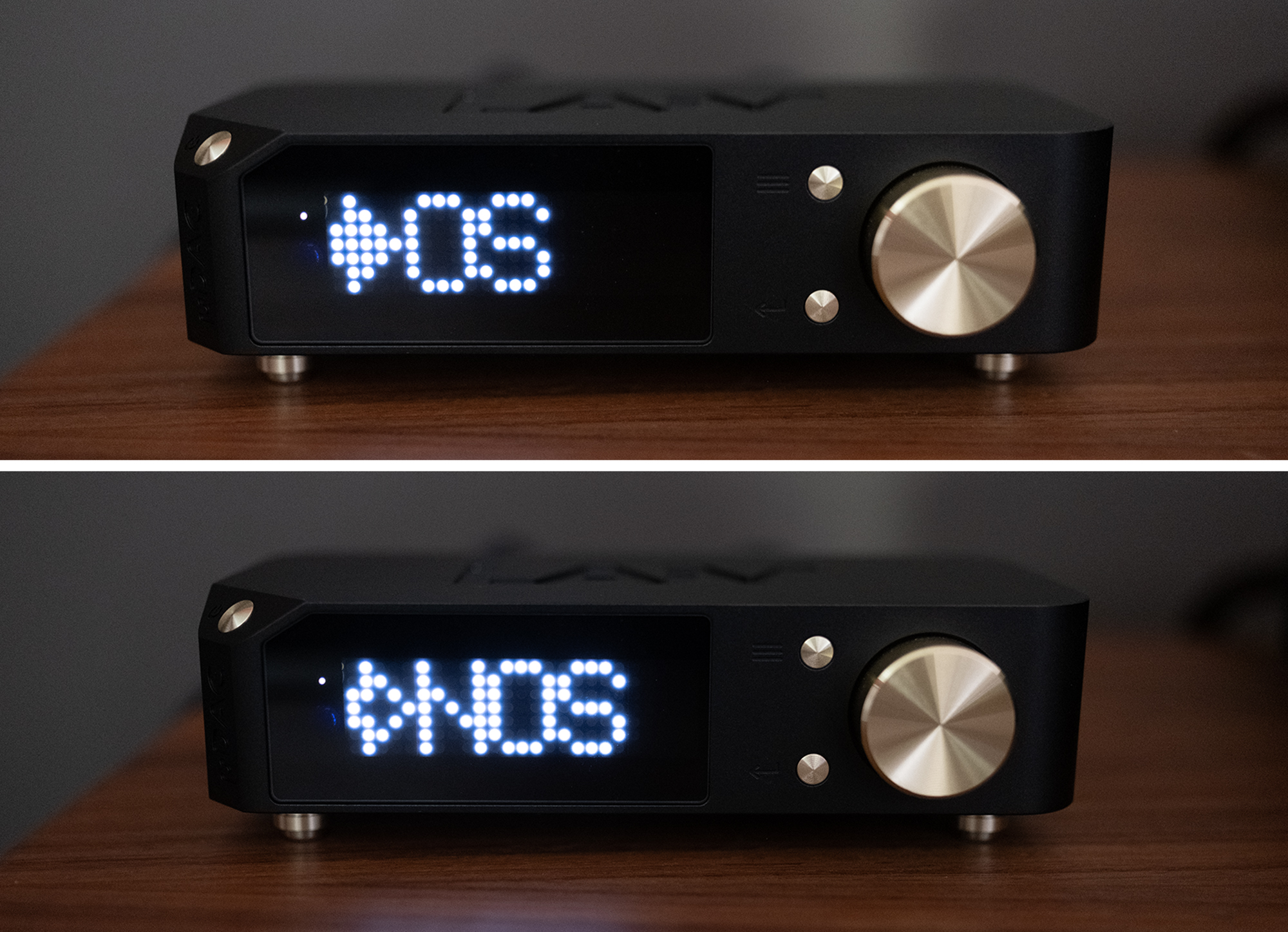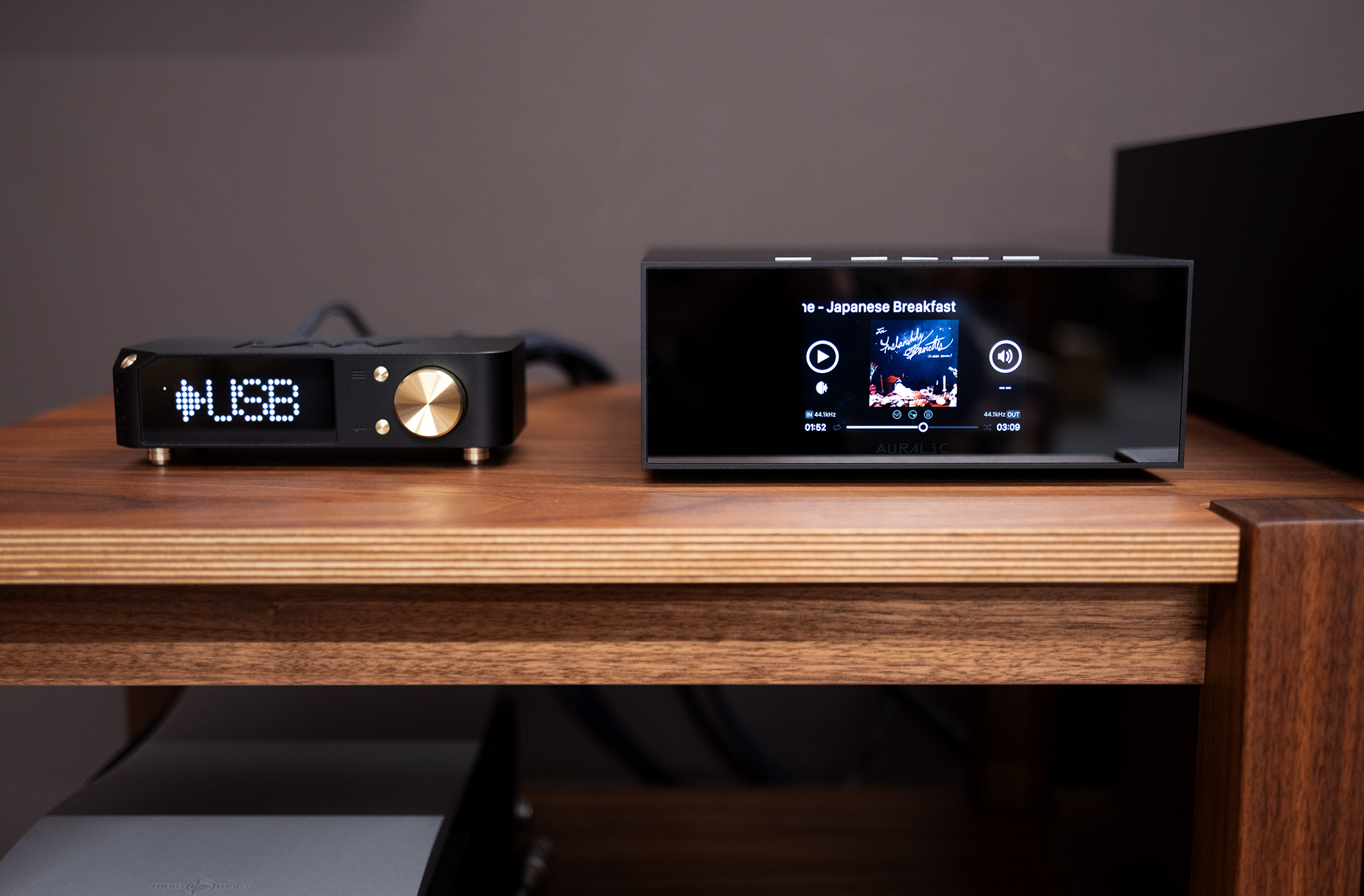
The Harmony µDAC from LAiV Audio is a remarkable DAC when it comes to price, performance, and build quality.
What’s more, you can tweak its sound to your taste using either the NOS (non-oversampling) or OS (oversampling) mode. Some listeners might like to switch back and forth, which is fine, but I’m more of a set it to the one I prefer and forget it. For my tastes, I stuck with NOS once I’d A/B’s enough to know for sure.
Speaking of A/B, I compared the Harmony µDAC (aka ‘micro’ DAC) to an older Denafrips ARES II I had on hand, another very nice sounding DAC I reviewed back in 2021. But I’m getting ahead of myself.

The Harmony µDAC employs an FPGA before its proprietary balanced discrete R-2R Ladder Network to perform a number of functions including that NOS or OS option. There’s an Accusilicon AS318-B Ultra-Low Phase Noise FEMTO Oscillator/clock to keep the bits running smoothly as well as galvanic isolation between the digital side and the analog side to keep the former’s noise out of the output while the output stage uses a Discrete Class A output buffer. Another FPGA-based function is the ability to choose between 8 I2S configurations to help mate to your DAC (I2S does not have a standard pinout). The I2S input also allows for the use of an external I2S-based master clock.
Here’s LAiV on the importance of galvanic isolation:
In high-fidelity digital audio systems, preserving signal integrity is paramount, and galvanic isolation between digital and analog components plays a crucial role in achieving this. By electrically decoupling the digital and analog sections, galvanic isolation eliminates unwanted ground loops and minimizes noise transmission, ensuring a cleaner, interference-free signal path. This results in lower jitter, reduced distortion, and improved overall clarity in audio reproduction.

Around back reside 4 digital inputs (I2S, Coax, Toslink, and USB), a pair of balanced XLR outputs, and 15V DC in for the included external power supply. It’s worth noting two things about power while we’re here—having an external power supply allows for a smaller chassis while keeping noise away from the important parts, and you can always add your own favorite external power supply if you care to roll your own. Don’t do XLR? No worries as you can buy a pair of XLR>RCA adapters for a few bucks.

The Harmony µDAC’s tiny chassis is milled from a solid billet of aluminum that comes in silver or black and its front face sports an LED display and 3 gold buttons for power, menu, and select functions. A matching gold knob is used to scroll between menu option and input selection. About the size of a 1980’s cell phone, the Harmony µDAC feels nice and solid and there’s no fault I could find in terms of build quality. Menu options include the aforementioned NOS/OS option, Phase, Display (brightness, DIM, or Off), I2S modes, Firmware version, and Factory Reset. Firmware updates are accomplished by downloading the latest and copying it over to the µDAC’s micro SD which is located on the unit’s underbelly. There’s also a matching optional remote control ($194) which was not included for this review.
I don’t normally include a manufacturer’s video in a review but this one from Alvin Chee at Vinshine Audio is too good not to share when it comes to looking at and talking about the µDAC’s insides.
Told ya.

The µDAC lived on the Barn’s B-Side where it was fed from the recently reviewed Auralic ARIES S1 streamer using a short length of AudioQuest Carbon USB cable. On the other end of the µDAC, a pair of AQ XLR cables brought the analog signal to the review Aesthetix Mimas integrated amp (more info) which drove the Barn resident DeVore O/96 (review) very nicely I might add. Everything, except the speakers, sat on my MD3S Modular rack from Box Furniture (see full Barn and system details).
The µDAC arrived in Barn back in March and it has seen a lot of play time and a lot of music, too many albums and tracks to list. I find that listening over time over weeks that turn into months to be the best way to get to know an unfamiliar product. First impressions are all well and good but if you’ve ever dated you know their potential pitfalls. That said, the little µDAC was kinda familiar in that I reviewed its bigger brother, the similarly-named and more costly Harmony DAC (review) back in July of last year.
Here’s part of what I concluded:
The LAiV Harmony DAC offers exceptional performance and build quality and I don’t know of any real competition anywhere near its price. To put it another way, if you want a better DAC than the Harmony, be prepared to spend more.
Not to give away this review’s ending, I would say the same thing about the µDAC only with a bit more enthusiasm.
Regular readers with good memories may recall my playlist called “fun” where I keep all my ‘test tracks’. Today, there are more than 250 tracks of all shapes, sizes, genres, and eras. I recently added FKA twigs “Cellophane” from her 2019 album Magdalene, a track I used for some my A/B’ing which led me to (re)listen to the entire album. I had the good fortune to see a show from this tour and was an audio/visual spectacle in the best possible way. Like nearly all of her music, Magdalene is filled with all manner of sounds, acoustic, electric, and eclectic so it offers a nice workout for a hifi. There’s also lots of spatial information in this mix, with sounds and vocals spread out around a large soundscape and the little µDAC did a great job of sorting all this out, giving distinct voice to the varied voices while spreading the sound image out into a well defined and large space.

I will share here that I used “Cellophane” and a few other test tracks to compare NOS and OS modes in the µDAC and I clearly preferred NOS for its greater sense of body and dynamics while offering a very nice level of resolution and nuance. OS mode upped the ante on resolution but tipped that scale too far away from body and overall physicality for my taste. The important takeaway is these modes are a very nice to have option, imo.
I was pointed to the English band These New Puritans by a number of favorite musicians I follow on Instagram including Caroline Polachek who appears here. I don’t know about you but I value musician’s opinions on music more than a critic and the same holds for art and literature for the most part. The band’s latest album Crooked Wing was released in May and it’s a wondrous intricate journey in song and sound. I have a confession—naming a song “A Season in Hell” will get a smile from me, “Once, if I remember well, my life was a feast where all hearts opened and all wines flowed.” (I still prefer the Louise Varèse translation).
Sounding like the offspring of The Fall, Talk Talk, and Scott Walker, Crooked Wing is an ecstatic ramble around genres with operatic ambition. Think big music thinking big. And the little µDAC kept pace, drawing a big sound image that was also well defined and rich, rich in tone, texture, and body that helped convey the drama packed into this dramatic record. My only comparative criticism albeit when compared to much more costly DACs is the µDAC sounds thinner and less fleshed out as if a fine slightly opaque film was stretched out between me and the music. But I’m talking about an unreasonable challenge simply to point out that more can buy better, which should be obvious seeing as LAiV make a more expensive DAC as one easy example to prove that point.

As a reminder, the ARES II I have is as old as my review, c.2021, and there’s a newer version I have not heard. When I reviewed this ARES II, it was priced at $780, so roughly in the same ballpark as the µDAC. In terms of sound and sound quality, I prefer the µDAC for its superior resolution, greater differentiation between tones and textures, and overall more dynamic sound. But, the ARES II has some wonderful qualities of its own, namely a big bear hug kinda sound that is happier with delivering the big picture in a comparatively less precise manner. Some people might (mistakenly) take that warmer and fuzzier feel as sounding ‘less digital’ but to my mind the µDAC is even more less digital as it reveals more of the music.
If you look at my list of Favorite DACs, the closest entry is the Wattson Emerson Analog streaming DAC (review) which costs $1750 but seeing as it’s all-in-one where you need to add a streaming source to the µDAC, they are on similar footing price wise. While it’s been too long since the Emerson Analog left, about a year and a half ago, I cannot make any direct comparisons here. To my mind the Emerson Analog is a very appealing package for anyone looking for a simple streaming DAC solution in an even smaller chassis. On the other hand, if the µDAC’s NOS/OS modes are attractive and/or its I2S capabilities, that’s something to help sway you LAiV’s way and the Holo Red DDC & Network Streamer for $798 (review) would make for a nice partner or if you prefer a bit more visuals, the Auralic ARIES S1 fits that bill.
Of course I could compare the µDAC to the Barn resident Mola Mola Tambaqui or totaldac d1-unity but what would be the point? To point out that these much more expensive DACs are better, and they are, but use a % to grade the difference? “You’re getting XX% of the performance for a fraction of the price!” Sounds great if you’re selling lower priced stuff but when listening to music—especially when that’s all you’re doing—%s are meaningless when it comes to musical involvement where a 20% perceived difference in sound quality can add up to a 120% more meaningful experience. And we haven’t even touched on system context which is 1,000% more important than even a 30% perceived difference between DACs. If you haven’t noticed, I think using %s to talk about relative hifi performance is kinda silly.
Another album from a UK-based band that I compared to Talk Talk that’s been seeing lots of plays of late in Barn is the new one from Quade, The Foal Tower released on AD 93 back in April.
From the liner notes:
It is a deep, dense record that is stuffed with musical, cinematic and literary influences – from Ursula La Guin and Cormac MacCarthy through to RS Thomas and Yeats – but despite the heavy, introspective and anxious nature of some of the material, it is also a record that is remarkably deft, agile and considered.
I have a confession—naming a song “Beckett” will get a smile from me, “I took advantage of being at the seaside to lay in a store of sucking-stones. They were pebbles but I call them stones. Yes, on this occasion I laid in a considerable store. I distributed them equally between my four pockets, and sucked them turn and turn about.”
The production here was done with real care and many of the songs have a skeletal structure where every element is the most important. All to say, you really want a DAC that can lend a believable voice and impact to all of it and I am happy to report that the µDAC did a remarkable job at all of the above, remarkable considering its price. And to dot that last “i”, the µDAC does not exhibit any signs or sounds of poorly done digital and my best guess is it’s because it’s very well done digital.

We end how we began—the Harmony µDAC from LAiV Audio is a remarkable DAC when it comes to price, performance, and build quality. There was a gaping hole on my list of Favorite DACs in the $1000 neighborhood and the little µDAC fits perfectly with plenty of room to spare.
LAiV Audio Harmony µDAC
Price: $994
Company Website: LAiV Audio
Specifications
Chip: Intel Altera Cyclone FPGA
Clock: Accusilicon AS318-B Ultra-Low Phase Noise FEMTO Oscillator
Digital Inputs: 1 x USB, 1 x Optical, 1 x Coaxial, 1 x I2S
Analog Outputs: 1 x XLR, maximum at 4 Vrms, approx. 82 Ω
Supported Formats (Input dependent)
USB: PCM:44.1kHz – 768kHz | DSD: DSD64 – DSD256
Optical: PCM: 44.1kHz – 192kHz | DSD: DSD64 via DoP only
Coaxial: PCM: 44.1kHz – 192kHz
DSD: DSD64 via DoP only
I2S: PCM: 44.1kHz – 768kHz | DSD: DSD64 – DSD256
Frequency Response: 20Hz – 20kHz, within ± 0.25 dB
THD+N: 0.006 %
Crosstalk: ≤ -120 dB
Signal to Noise Ratio (SNR): ≥ 125 dB
Dynamic Range: ≥ 110 dB
Features
Sleek & Compact design
NOS / OS Mode
Positive / negative phase
Display brightness, delay dim, and delay off
8 x I2S Mode with Laiv product auto-configured
I2S clock supported
Galvanic isolation for enhanced signal purity
LAiV Harmony R-2R ladder network architecture
Discrete class A output buffer.
Controls: Remote control | Front panel
Power: 15VDC / 2A, DC 5.5/2.5 mm female.
In the Box
Welcome card with Quick Start guide
Harmony µDAC
Power adapter with interchangeable plugs
Warranty: 24-month limited warranty.

